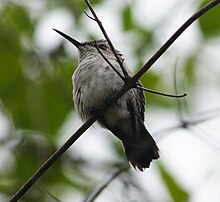The bee hummingbird or Zunzuncito (Mellisuga helenae) is a species of hummingbird. It lives in Cuba's Isla de la Juventud. It is the smallest bird in the world with an average length of only 5-6 cm.[2][3][4]
| Bee hummingbird | |
|---|---|
 | |
| Scientific classification | |
| Kingdom: | |
| Class: | |
| Order: | |
| Family: | |
| Genus: | Mellisuga |
| Binomial name | |
| Mellisuga helenae | |
A newly hatched bee hummingbird chick may weigh about a fingernail clipping.[5] Its weight is less than a tenth of an ounce (2 g). Because of this, it is the smallest living bird[6] as well as the smallest theropod dinosaur on record. Females grow to up to 6.1 centimeters (2.4 inches) long, weighing around 2.6 grams (0.092 ounces). Male bee hummingbirds grow to be 5.51 centimeters (2.17 inches) long, weighing around 1.95 grams (0.069 ounces).[7]
Male hummingbirds have a red throat and head, with long neck feathers. They have a light underside, spotted blue wing tips and black tipped tail feathers. The rest of the feathers are blue or green.[8] Females have green parts and white tips to the tail feathers. After mating season, the birds become dull and gray in color.[9]
When flying, bee hummingbirds beat 80 times a second. During courtship flight, they beat up to 200 times per second.[10]
When they are hatched, they are blind and nearly naked. The mother feeds the hatchlings by regurgitating for 20-40 days while she stays over the nest. Only after their wing feathers are grown will the hatchlings leave the nest (around 23 days after hatching).[11]
References
Wikiwand in your browser!
Seamless Wikipedia browsing. On steroids.
Every time you click a link to Wikipedia, Wiktionary or Wikiquote in your browser's search results, it will show the modern Wikiwand interface.
Wikiwand extension is a five stars, simple, with minimum permission required to keep your browsing private, safe and transparent.

